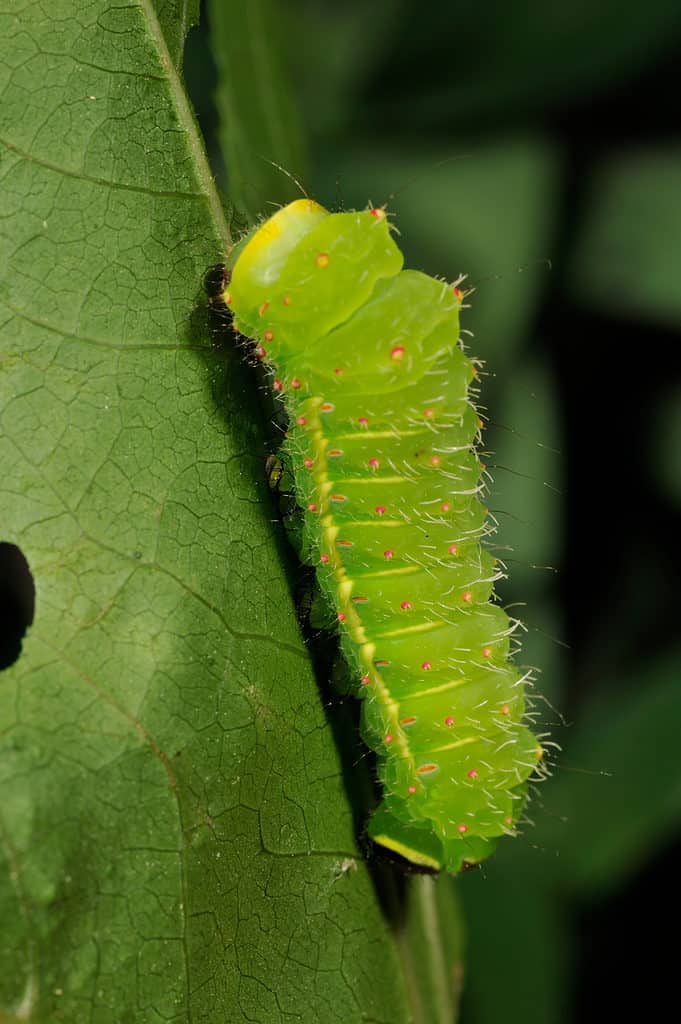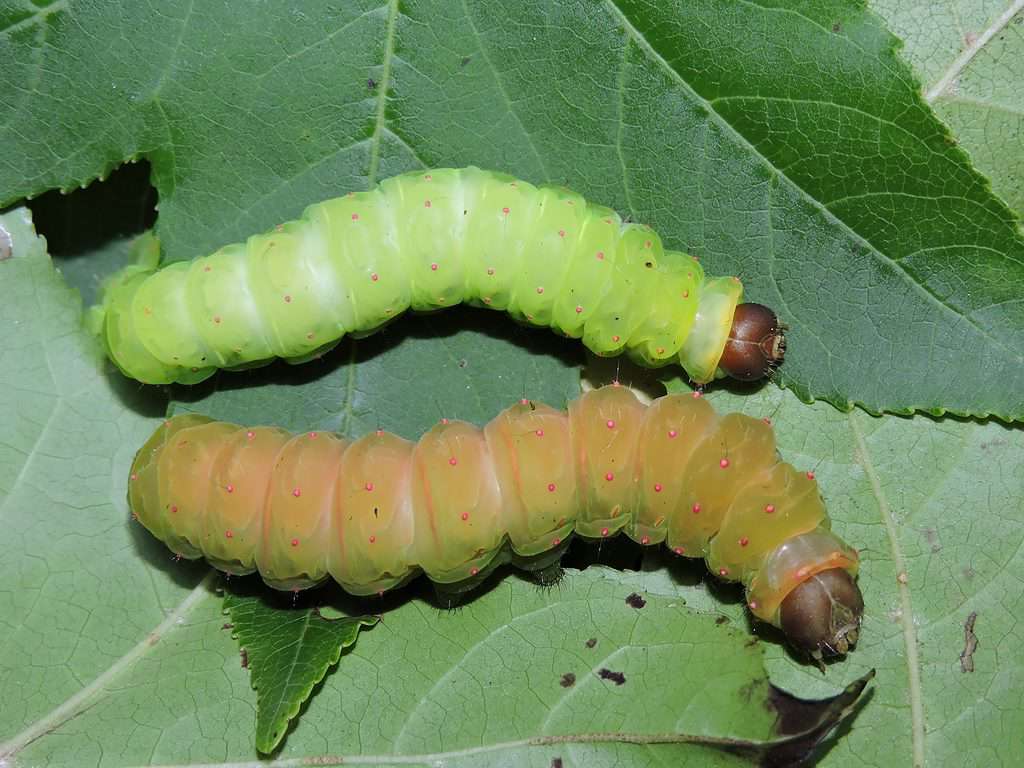Luna Moth Caterpillar
Actias luna
A luna moth caterpillar weighs less than 1 ounce.
Advertisement
Luna Moth Caterpillar Scientific Classification
- Kingdom
- Animalia
- Phylum
- Arthropoda
- Class
- Insecta
- Order
- Lepidoptera
- Family
- Saturniidae
- Genus
- Actias
- Scientific Name
- Actias luna
Read our Complete Guide to Classification of Animals.
Luna Moth Caterpillar Conservation Status
Luna Moth Caterpillar Facts
- Prey
- tree leaves
- Main Prey
- tree leaves
- Name Of Young
- N/A
- Group Behavior
- Solitary
- Fun Fact
- A luna moth caterpillar weighs less than 1 ounce.
- Estimated Population Size
- Undetermined
- Biggest Threat
- Habitat loss
- Most Distinctive Feature
- bright green body
- Distinctive Feature
- orange dots on bright green body
- Other Name(s)
- N/A
- Gestation Period
- N/A
- Temperament
- docile, solitary
- Wingspan
- N/A
- Training
- N/A
- Optimum pH Level
- nN/A
- Incubation Period
- N/A
- Age Of Independence
- birth
- Age Of Fledgling
- N/A
- Average Spawn Size
- N/A
- Litter Size
- N/A
- Habitat
- forests and woodlands
- Predators
- birds, spiders, beetles, wasps, small mammals
- Diet
- Herbivore
- Lifestyle
- Diurnal
- Favorite Food
- tree leaves
- Type
- Actias luna
- Common Name
- luna moth caterpillar
- Special Features
- green body
- Origin
- North America
- Number Of Species
- 250
- Location
- North America
- Slogan
- N/A
- Group
- eclipse
- Nesting Location
- N/A
- Age of Molting
- various times throughout its life.
Luna Moth Caterpillar Physical Characteristics
- Color
- Green
- Skin Type
- Exoskeleton
- Lifespan
- 1 month
- Weight
- less than one ounce.
- Height
- 0.25-0.5 inches
- Length
- 1-2.5 inches
- Age of Sexual Maturity
- N/A
- Age of Weaning
- N/A
- Venomous
- No
- Aggression
- Low
View all of the Luna Moth Caterpillar images!
The luna moth caterpillar (Actias luna), is the larval stage of the luna moth, a large green moth found in North America. The caterpillars have a waffle-iron-like texture to their segmented bodies, which are green with tiny orange dots on the raised squares. Sparse bristly hairs cover their bodies. They feed on a variety of trees, growing to be around 2-2.5 inches in length before entering the pupal stage. The luna moth caterpillars are typically active during the spring and summer and will spin a cocoon made of silk and leaves in which to pupate. Keep reading to learn more about Actias luna.
Five Frank Facts about Luna Moth Caterpillars
- Luna moth caterpillars are the larval stage of the luna moth, a large green moth found in North America.
- They feed on a variety of trees, including walnut, hickory, and persimmon.
- Luna moth caterpillars grow to be around 2-2.5 inches in length before entering the pupal stage.
- They are typically active during the spring and summer months.
- They spin a cocoon made of silk and leaves in which to pupate.
Luna Moth Caterpillar: Scientific Name
The scientific name for the luna moth caterpillar is Actias luna. The caterpillar shares its name with its adult form, the luna moth. Its Latin name translates to active moon. And while it’s true that as adult moths they are most active at night, luna moth caterpillars are actually diurnal. However, the luna moth gets its name from the moon-like spots on its hindwings. The family name Saturniidae refers to the false eyes or eyespots of concentric rings, that resemble the rings of the planet Saturn.
Appearance
A luna moth caterpillar is typically bright green with a series of small orange spots dotting the length of its textured body. It has a pair of black, triangular-shaped markings on its back near the head, as well as a pair of orange or reddish-orange spots near the tail. The body is also covered in short, fine hairs. It typically grows to be 2-2.5 inches long. The weight of a luna moth caterpillar can vary depending on the individual and the stage of its development. However, generally speaking, a luna moth caterpillar weighs between 0.03 – 0.105 ounces.

A luna moth caterpillar is typically bright green with a series of small orange spots dotting the length of its textured body.
©Breck P. Kent/Shutterstock.com
Luna Moth Caterpillar: Behavior
Luna moth caterpillars are primarily active during the daytime, feeding on the leaves of trees and plants. They are relatively slow-moving and do not have the ability to sting or bite. They are also solitary creatures and do not form colonies or congregate in large groups. As they get closer to pupating, they will stop eating and look for a place to spin their cocoon.
Habitat / Diet
These caterpillars can be found in many different types of forest habitats in North America. They live in deciduous woods, hardwood bottoms, and pine-hardwood forests. They are also found in gardens and backyards where host plants are about. These caterpillars prefer trees such as hickory, walnut, and sweetgum. The leaves of these trees are the main food source for the caterpillars. They also can be found on cherry, plum, and apple trees. Their lives are spent feeding on the leaves of the host tree, although they will move to other trees to find food or to pupate.
Predators
Luna moth caterpillars have a variety of predators, including:
- Birds: Many species of birds, such as robins, blue jays, and woodpeckers, will eat luna moth caterpillars.
- Wasps: Wasps such as paper wasps and yellow jackets are predators. Paper wasps are parasites. They lay their eggs in the caterpillars, which then hatch and use the caterpillar as a source of food, killing it.
- Spiders: Several species of spiders including orb-weavers and jumping spiders will prey on luna moth caterpillars.
- Beetles: Ground beetles and ladybugs will eat them.
- Other insects: Many types of insects such as ants, lacewings, and stinkbugs are other known predators.
- Some small mammals like shrews and chipmunks are also known to feed on them.
- It is worth noting that luna moths also have natural predators like bats, which feed on adult luna moths during their short life.
Threats
Luna moth caterpillars face a variety of threats in their natural habitats. Some of the main threats they face include:
- Habitat loss: The conversion of natural habitats to developed areas, such as urbanization and agriculture, reduces the availability of suitable trees for luna moth caterpillars to feed on and also reduces the number of trees for adult luna moths to lay their eggs on.
- Pesticides/herbicides: The use of pesticides and herbicides kills luna moth caterpillars. Pesticides can kill them directly by exposing the caterpillars to toxins. Herbicides can affect their viability by killing the plants they feed on.
- Climate change: Climate change affects the distribution, abundance, and timing of luna moth caterpillars and their host plants, ultimately affecting the population of the species.
- Light pollution: Adult luna moths are attracted to lights, which can lead them to fly into buildings or other man-made structures, leading to injury or death.
- Collection: Some individuals may collect luna moth caterpillars as pets or for observation, which disrupts the population and the ecosystem in which they live.
- Other human activities such as logging, mining, and oil and gas drilling also have a negative impact on the habitat of luna moths, and their caterpillars.
- Overall, the population of luna moths has been in decline, and conservation efforts are needed to protect and preserve their habitats, as well as to raise awareness of the importance of these insects.
Conservation Status
Though the conservation status of individual species is bestowed on the adult form which is responsible for reproduction, the luna moth caterpillar, like its adult form, is not considered to be a threatened or endangered species and does not have a designated conservation status. However, like many other moth and butterfly species, luna moths may be at risk due to habitat destruction and pesticide use.
Lifecycle/Lifespan
The luna moth caterpillar goes through four stages in its lifecycle: egg, larva, pupa, and adult.
Female luna moths lay their eggs on the leaves of trees and shrubs that are preferred food sources for the caterpillars, such as hickory, walnut, and sweetgum. The eggs are small, round, and green in color. They hatch in about a week. After the eggs hatch, the caterpillars begin to feed on the leaves of the host plant. They go through several molts (also called instars or shedding) of their exoskeleton, as they grow. During this stage, they are green in color and can grow up to 2.5 inches long. When the caterpillar has reached its full size, it begins to turn brown. Next, it will stop eating and spin a cocoon, entering the pupal stage. The pupa is brown and about 1.5 inches long. It will stay in the cocoon for about two weeks before emerging as a luna moth.
Luna moths are large, beautiful insects with translucent green wings.
The lifespan of a luna moth caterpillar is approximately one month. The lifespan of the luna moth is much shorter, at about 1 week.

When the caterpillar has reached its full size, it begins to turn brown.
©TamiG/Shutterstock.com
Population
The population of luna moth caterpillars is not specifically tracked and there are no exact numbers available. The luna moth, like many other species of moths and butterflies, can fluctuate in population size depending on a variety of factors such as habitat loss, disease, weather, predation, and pesticide use. While the luna moth is not considered to be threatened or endangered, the population is declining in some areas.
Up Next:
View all 98 animals that start with LLuna Moth Caterpillar FAQs (Frequently Asked Questions)
What does a luna moth caterpillar look like?
A luna moth caterpillar is typically bright green with a series of small orange spots dotting the length of its textured body. It has a pair of black, triangular-shaped markings on its back near the head, as well as a pair of orange or reddish-orange spots near the tail. The body is also covered in short, fine hairs. It typically grows to be 2-2.5 inches long.
What do luna moth caterpillars eat?
Luna moth caterpillars eat the leaves of a variety of different trees. They prefer trees such as hickory, walnut, and sweetgum. They also can be found on cherry, plum, and apple trees. The leaves of these trees are the main food source for the caterpillars.
What are some of the luna moth caterpillar's [redators?
The luna moth has a variety of predators including birds, wasps, spiders, and beetles. Some small mammals like shrews and chipmunks are also known to feed on them.
What are some threats that Luna Moth caterpillars face?
Luna moth caterpillars face a variety of threats from habitat loss and climate change to pesticides and herbicides. Oil and gas drilling all have a negative effect on their habitats.
What is the average lifespan of a luna moth caterpillar?
Luna moth caterpillars live for about 1 month.
Thank you for reading! Have some feedback for us? Contact the AZ Animals editorial team.
Sources
- fllt.org / Accessed January 22, 2023
- iucnredlist.org / Accessed January 22, 2023
- wikipedia.org / Accessed January 22, 2023


















